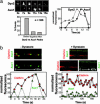A burst of auxilin recruitment determines the onset of clathrin-coated vesicle uncoating
- PMID: 16798879
- PMCID: PMC1502446
- DOI: 10.1073/pnas.0603369103
A burst of auxilin recruitment determines the onset of clathrin-coated vesicle uncoating
Abstract
Clathrin-coated pits assemble on a membrane and pinch off as coated vesicles. The released vesicles then rapidly lose their clathrin coats in a process mediated by the ATPase Hsc70, recruited by auxilin, a J-domain-containing cofactor. How is the uncoating process regulated? We find that during coat assembly small and variable amounts of auxilin are recruited transiently but that a much larger burst of association occurs after the peak of dynamin signal, during the transition between membrane constriction and vesicle budding. We show that the auxilin burst depends on domains of the protein likely to interact with lipid head groups. We conclude that the timing of auxilin recruitment determines the onset of uncoating. We propose that, when a diffusion barrier is established at the constricting neck of a fully formed coated pit and immediately after vesicle budding, accumulation of a specific lipid can recruit sufficient auxilin molecules to trigger uncoating.
Conflict of interest statement
Conflict of interest statement: No conflicts declared.
Figures





Similar articles
-
Dynamics of Auxilin 1 and GAK in clathrin-mediated traffic.J Cell Biol. 2020 Mar 2;219(3):e201908142. doi: 10.1083/jcb.201908142. J Cell Biol. 2020. PMID: 31962345 Free PMC article.
-
Recruitment dynamics of GAK and auxilin to clathrin-coated pits during endocytosis.J Cell Sci. 2006 Sep 1;119(Pt 17):3502-12. doi: 10.1242/jcs.03092. Epub 2006 Aug 8. J Cell Sci. 2006. PMID: 16895969
-
Structure of the PTEN-like region of auxilin, a detector of clathrin-coated vesicle budding.Structure. 2010 Sep 8;18(9):1191-8. doi: 10.1016/j.str.2010.06.016. Structure. 2010. PMID: 20826345 Free PMC article.
-
Multiple roles of auxilin and hsc70 in clathrin-mediated endocytosis.Traffic. 2007 Jun;8(6):640-6. doi: 10.1111/j.1600-0854.2007.00568.x. Epub 2007 May 4. Traffic. 2007. PMID: 17488288 Review.
-
Endocytosis: clathrin-mediated membrane budding.Curr Opin Cell Biol. 2007 Aug;19(4):417-25. doi: 10.1016/j.ceb.2007.05.003. Epub 2007 Jul 13. Curr Opin Cell Biol. 2007. PMID: 17631994 Review.
Cited by
-
Live-cell imaging of clathrin coats.Methods Enzymol. 2012;505:59-80. doi: 10.1016/B978-0-12-388448-0.00012-7. Methods Enzymol. 2012. PMID: 22289448 Free PMC article.
-
Structure of clathrin coat with bound Hsc70 and auxilin: mechanism of Hsc70-facilitated disassembly.EMBO J. 2010 Feb 3;29(3):655-65. doi: 10.1038/emboj.2009.383. Epub 2009 Dec 24. EMBO J. 2010. PMID: 20033059 Free PMC article.
-
Endosomal recycling controls plasma membrane area during mitosis.Proc Natl Acad Sci U S A. 2007 May 8;104(19):7939-44. doi: 10.1073/pnas.0702511104. Epub 2007 May 1. Proc Natl Acad Sci U S A. 2007. PMID: 17483462 Free PMC article.
-
Nanodissected elastically loaded clathrin lattices relax to increased curvature.Sci Adv. 2021 Aug 13;7(33):eabg9934. doi: 10.1126/sciadv.abg9934. Print 2021 Aug. Sci Adv. 2021. PMID: 34389539 Free PMC article.
-
CED-6/GULP and components of the clathrin-mediated endocytosis machinery act redundantly to correctly display CED-1 on the cell membrane in Caenorhabditis elegans.G3 (Bethesda). 2024 Jul 8;14(7):jkae088. doi: 10.1093/g3journal/jkae088. G3 (Bethesda). 2024. PMID: 38696649 Free PMC article.
References
-
- Ehrlich M., Boll W., Van Oijen A., Hariharan R., Chandran K., Nibert M. L., Kirchhausen T. Cell. 2004;118:591–605. - PubMed
-
- Lemmon S. K. Curr. Biol. 2001;11:R49–R52. - PubMed
-
- Greener T., Zhao X., Nojima H., Eisenberg E., Greene L. E. J. Biol. Chem. 2000;275:1365–1370. - PubMed
-
- Jiang J. W., Taylor A. B., Prasad K., Ishikawa-Brush Y., Hart P. J., Lafer E. M., Sousa R. Biochemistry. 2003;42:5748–5753. - PubMed
Publication types
MeSH terms
Substances
Grants and funding
LinkOut - more resources
Full Text Sources
Other Literature Sources
Molecular Biology Databases
Miscellaneous

